
Genus Dolerocypris Kaufmann, 1900
Superfamily: Cypridoidea Baird, 1845
Family: Cyprididae Baird, 1845
Subfamily: Dolerocypridinae Triebel, 1961
1. Dolerocypris fasciata (O.F. Müller, 1776)
- Figures in: Meisch 2000.
- Habitat: Littoral zone of lakes, especially around water weeds, ponds and swamps (Meisch 2000).
- Mode of life: Nektobenthic (swimmer).
- Reproduction mode: Asexual, males unknown.
- Known distribution: Found throughout South Korea (Kim & Min 1991). Generally, Holarctic (Meisch 2000).
- References:
- ⚬ Kim, W. & Min, G. S. 1991. Redescription of recent freshwater ostracods (Crustacea: Ostracoda) from Korea: A systematic study of four species of family Cyprididae. Korean Journal of Systematic Zoology, 7, 81-100.
- ⚬ Meisch, C. 2000. Freshwater Ostracoda of Western and Central Europe. In: Schwoerbel, J., Zwick, P., (Eds.), Süßwasserfauna von Mitteleuropa 8/3. Spektrum Akademischer Verlag, Heidelberg, Berlin 522 pp.
2. Dolerocypris ikeyai Smith & Kamiya, 2006
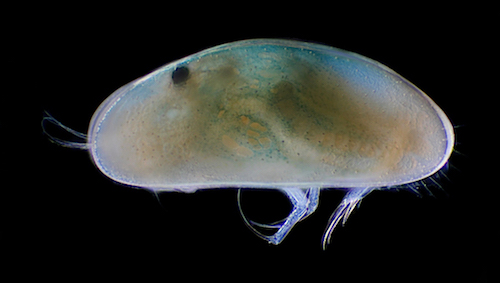
Left side view of a female Dolerocypris ikeyai, length about 1.1 mm. In this genus, the right valve overlaps the left. The colour of the carapace varies from green through to pale green/blue to white.
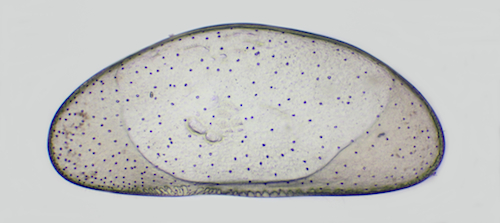
External view of a female left valve of Dolerocypris ikeyai, length 1066 microns.
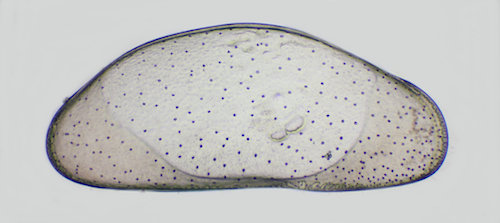
External view of a female right valve of Dolerocypris ikeyai, length 1078 microns.
- Additional figures in: Smith & Kamiya 2006; Smith 2011; Chang et al. 2012.
- Habitat: Typically found in the runoff of small springs and seeps.
- Mode of Life: Benthic.
- Mode of reproduction: Sexual populations are known from two small Japanese islands, Yakushima and Tagashima. Elsewhere, asexual.
- Distribution: South Gyeongsang Province, North Gyeongsang Province (Chang et al. 2012). Elsewhere, known from Japan (Smith 2011; Tanaka et al. 2015).
- References:
- ⚬ Chang, C. Y., Lee, J. & Smith, R. J. 2012. Nonmarine ostracods (Crustacea) from South Korea, including a description of a new species of Tanycypris Triebel (Cyprididae, Cypricercinae). Zootaxa, 3161, 1-19.
- ⚬ Smith, R. J. 2011. Groundwater, spring and interstitial Ostracoda (Crustacea) from Shiga Prefecture, Japan, including descriptions of three new species and one new genus. Zootaxa, 3140, 15-37.
- ⚬ Smith, R. J. & Kamiya, T. 2006. Six new species of fresh and brackish water ostracods (Crustacea) from Yakushima, Southern Japan. Hydrobiologia, 559, 331-355.
- ⚬ Tanaka, H., Kotorii, H., Yokozawa, K., Wakabayashi, F., Kimoto, K. & Sano, K. 2015. Distribution and occurrence of freshwater Ostracoda (Crustacea) from southwest region of Mt. Fuji. TAXA, Proceedings of the Japanese Society of Systematic Zoology, 38, 26-41. [In Japanese with English abstract.]
3. Dolerocypris sinensis Sars, 1903
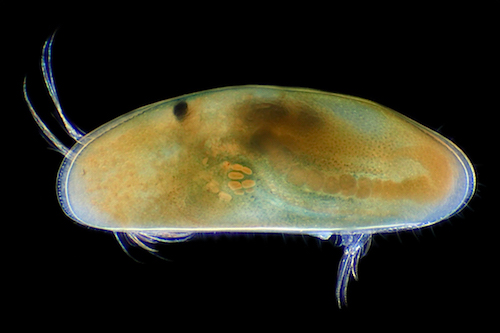
Left side view of a female Dolerocypris sinensis, length 1.9 mm. In this genus, the right valve overlaps the left.
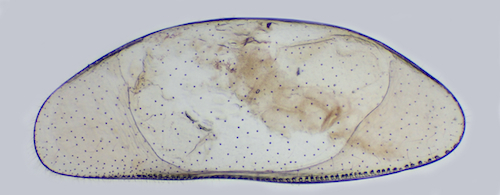
External view of a female left valve of Dolerocypris sinensis, length 1815 microns.
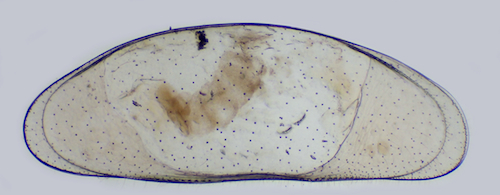
External view of a female right valve of Dolerocypris sinensis, length 1877 microns.
- Additional figures in: Meisch 2000.
- Habitat: Often found in rice fields (Okubo 1972) and the littoral zone of lakes (Meisch 2000).
- Mode of Life: Nektobenthic (swimmer).
- Mode of reproduction: Asexual, males unknown.
- Distribution: Found throughout South Korea (Kin & Min 1991; Smith et al. 2014). Generally, Eurasia (Meisch 2000).
- References:
- ⚬ Kim, W. & Min, G. S. 1991. Redescription of recent freshwater ostracods (Crustacea: Ostracoda) from Korea: A systematic study of four species of family Cyprididae. Korean Journal of Systematic Zoology, 7, 81-100.
- ⚬ Meisch, C. 2000. Freshwater Ostracoda of Western and Central Europe. In: Schwoerbel, J., Zwick, P., (Eds.), Süßwasserfauna von Mitteleuropa 8/3. Spektrum Akademischer Verlag, Heidelberg, Berlin 522 pp.
- ⚬ Okubo, I. 1972. Freshwater Ostracoda from Japan, I. Two species of the genus Dolerocypris Kaufmann, 1900. Review of Shujitsu Junior College, Okayama, 1, 41-60.
- ⚬ Smith, R. J., Lee, J. & Chang, C. Y. 2014. Nonmarine Ostracoda (Crustacea) from Jeju Island, South Korea, including descriptions of two new species. Journal of Natural History, http://dx.doi.org/10.1080/00222933.2014.946110, 1-40.